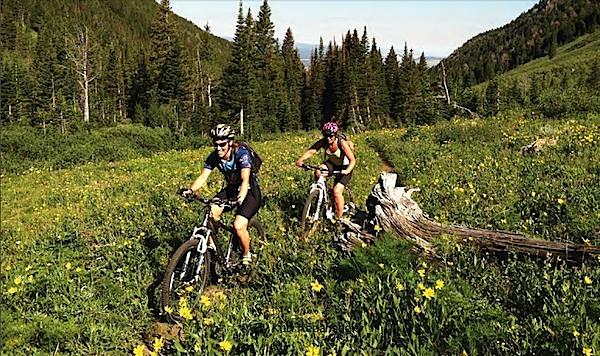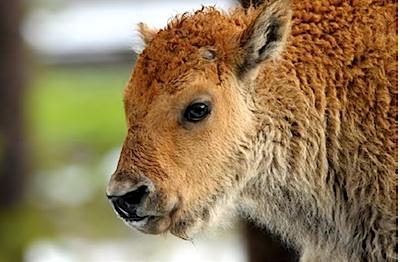
Once the surrounding hillsides and forests dry out from winter, mountain biking is a big lure for West Yellowstone / West Yellowstone Chamber.
Editor's note: This is a special advertiser-supported article from the Essential Park Guide, Spring 2014.
West Yellowstone is one of the smaller gateway towns you'll find in the National Park System...which isn't such a bad thing.
Walking the streets of West Yellowstone, I'm not in a hurry to move on into Yellowstone National Park. This Western way station has been around for more than a century, and it continues to intrigue visitors, both first-timers and repeaters. There are bookstores to lose yourself in, art galleries that reflect the Rocky Mountain atmosphere West Yellowstone is steeped in, wildlife on educational display, and history, both of the West in general and the national park specifically.
If your focus is on Yellowstone's geysers, West Yellowstone is a sound choice for your base camp. The drive to Old Faithful and its geyser basin is just 30 miles and about 45 minutes, maybe longer if you stop along the way to study bald eagles, elk, or bison, or to wet a line in the Madison River, a renowned trout fishery.
Also within easy reach on the ride to Old Faithful is the Firehole Canyon Drive, Fountain Flat Drive, Fountain Paint Pots, the Midway Geyser Basin, and the Upper Geyser Basin along with Biscuit Basin and Black Sand Basin. And that's without taking any hikes. The Norris Geyser Basin, the hottest thermal area in the park and arguably the most colorful, is also a short drive away from West Yellowstone.

Spring offers the chance to spotty shaggy bison calves/Pamela Talasco.
Springtime conspires to help you soak in this town, as the season can quickly close the entrance to Yellowstone with a snowstorm. Because one day can be mild and sunny, the next stormy with rain and snow squalls, to make the most out of your spring visit you must be flexible, willing to shrug a shoulder to the weather while pulling your hat down, and know your options.
That's where West Yellowstone, which sidles comfortably up to the national park's western border, stands ready to help you make the most of your visit. Whether spring snowstorms close the park's roads, or if you're just looking to truly experience this corner of the Rocky Mountains, West Yellowstone can help you out.
You can see that walking about this town of about 1,200 residents. Sure, the lodgepole forests of Yellowstone stand beckoning at the eastern end of Yellowstone Avenue. But they're not going anywhere, and if snows close the roads, you're not heading there, unless on foot. That's when West Yellowstone's tourism sector works especially hard to see you return home with great memories.
You can start by stopping by the Chamber of Commerce office (30 Yellowstone Avenue) just outside the park entrance and pick up the West of Yellowstone Park brochure. This guide has a map of the area depicting not only the loop of highways that heads north, west, south, and back east to West Yellowstone, but notes where you might see bald eagles, osprey, bison, moose, and perhaps even grizzlies during the spring.
For the 64-mile 'Around the Block' spring wildlife tour, make sure that your camera is at the ready for shots of bison (including, possibly, newborn calves in their fuzzy red fur attire and wobbly legs), moose or elk on hillsides, even the chance shot of a mountain goat on the cliffs behind the Quake Lake Visitor Center at Hebgen Lake. Take the 90- to 120-mile roundtrip ride from West Yellowstone to Big Sky and you'll motor through a 20-mile stretch of the western-most section of Yellowstone National Park. This winding route takes you along portions of the Gallatin River, by the Lee Metcalf Wilderness Area, and into the Gallatin and Beaverhead-Deerlodge national forests. Those forests are great places to spot bears (both black and grizzly), bald eagles, and if you're lucky and sharp-eyed, otters playing in the river.
Of course, you can also settle into West Yellowstone to enjoy the national park's 'Cycle Only Days,' which run, roughly, from April 1-19, weather permitting. This is the perfect time for an out-and-back pedal from town into the park'as far as your legs and the snowplows allow'without worrying about dodging RVs, SUVs, trucks and sedans. At ride's end, West Yellowstone's restaurants and lodgings await your return. If you don't cycle, head to Boundary Street and follow the Riverside Trail into the park and down to the Madison River, keeping an eye out for bison. It's a great, mostly flat, 3-mile roundtrip trek whether you do it with hiking boots, snowshoes, or cross-country skis, all of which come in handy in spring.
If the weather forces you inside, head to the Yellowstone Historic Center (220 Yellowstone Avenue) to understand how Old Snaggletooth rose to fame, or to learn the history of stagecoach and rail travel to Yellowstone. Or take the family to the Yellowstone Imax Theater (101 South Canyon) to immerse yourself in a movie about Yellowstone's history and wonders. A great educational stop for young and old is the Grizzly and Wolf Discovery Center (201 South Canyon Street) that's home to bears and wolves that might have been put down if this facility didn't exist. Here they're on display to help you understand their roles in a healthy park ecosystem.
While searching out West Yellowstone in spring might be a necessity before Yellowstone's lodges are open, the town is a great base camp any month of the year if your focus is the western side of the national park. The town has plenty of accommodations, ranging from motel rooms to charming cabins to houses you can rent. One summer our extended family of seven rented a house in town that allowed us to save money both on lodging costs and by cooking our meals there. Come sundown, we headed for the deck to recount our daily adventures in Yellowstone while the clear skies overhead slowly became crowded with stars.
True, West Yellowstone is a small town. But that's a decided perk when you come to stay.

 Support Essential Coverage of Essential Places
Support Essential Coverage of Essential Places






